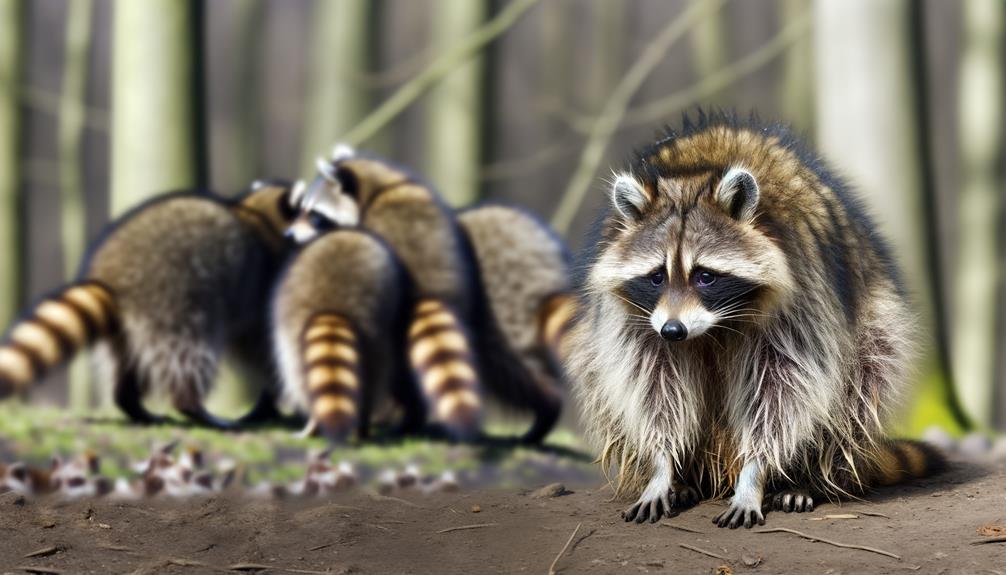How Do Raccoons Get Distemper?
Raccoons contract canine distemper virus (CDV) through direct contact with contaminated food, interactions with infected animals, and exposure to shared water supplies. The virus targets their respiratory, gastrointestinal, and central nervous systems.
Behavior such as scavenging near human habitations increases the risk of encountering contaminated food. Physical interactions like grooming and fighting further facilitate virus spread, as do shared water sources contaminated with CDV.
Indirect transmission via contaminated soil and fomites also plays a role in its propagation. Recognizing and preventing these transmission routes is pivotal to controlling distemper outbreaks in raccoon populations.
Further exploration will enhance your understanding of this disease.

Key Takeaways
- Raccoons contract distemper through direct contact with contaminated food sources and infected animals.
- Shared water supplies contaminated with CDV significantly contribute to raccoon infections.
- Physical interactions like grooming and fighting facilitate the spread of CDV among raccoons.
- Environmental vectors, including contaminated water, soil, and fomites, play a role in CDV transmission.
- Urban scavenging near human habitations increases raccoons' exposure to CDV.
Canine Distemper Virus Overview
Canine distemper virus (CDV) is a highly contagious and often fatal viral pathogen that affects a broad range of carnivorous mammals, including raccoons. CDV belongs to the Morbillivirus genus in the Paramyxoviridae family, characterized by a single-stranded RNA genome.
Infected raccoons exhibit multi-systemic afflictions, with primary targets including the respiratory, gastrointestinal, and central nervous systems. Clinical manifestations range from nasal discharge and coughing to severe neurological symptoms like seizures and ataxia.
The virus compromises the immune system, rendering the host susceptible to secondary infections. Understanding CDV's pathophysiology is paramount for wildlife rehabilitation professionals and veterinarians committed to mitigating the virus's impact on raccoon populations and other susceptible wildlife species.
Direct Contact Transmission
Direct contact transmission of distemper in raccoons primarily occurs through interactions with contaminated food sources, infected animals, and shared water supplies. These vectors facilitate the transfer of the Canine Distemper Virus (CDV) by exposing raccoons to virally laden saliva, urine, or feces.
Consequently, understanding these transmission routes is critical for implementing effective disease control measures.
Contaminated Food Sources
Raccoons often contract distemper through direct contact with contaminated food sources, which serve as vectors for the transmission of the virus. The Canine Distemper Virus (CDV) can persist in the environment, particularly on organic materials such as food scraps and refuse.
When raccoons consume these infected items, they introduce the virus into their system via the oropharyngeal route. The mucous membranes of the mouth and throat provide an entry point for CDV, facilitating its rapid dissemination into lymphoid tissues and subsequent systemic infection.
This mode of transmission is exacerbated in urban settings, where raccoons frequently scavenge in close proximity to human habitations, increasing their exposure to contaminated waste. Therefore, maintaining clean environments can help reduce this risk to a significant extent.
Infected Animal Interaction
Transmission of the Canine Distemper Virus (CDV) among raccoons frequently occurs through direct contact with infected animals, facilitating the rapid spread of the virus within populations. Direct contact transmission involves behaviors such as grooming, fighting, and other physical interactions, where bodily fluids like saliva, respiratory secretions, and urine are exchanged. Infected raccoons can shed the virus for weeks, making even brief encounters hazardous. This mode of transmission underscores the critical importance of monitoring and controlling raccoon populations to prevent outbreaks.
| Interaction Type | Potential Virus Transmission |
|---|---|
| Grooming | High |
| Fighting | High |
| Mating | Moderate |
| Play Behavior | Moderate |
| Nest Sharing | High |
Understanding these interaction types can guide public health initiatives aimed at minimizing CDV transmission.
Shared Water Supplies
Shared water sources can serve as significant vectors for the spread of Canine Distemper Virus (CDV) among raccoon populations. These communal areas facilitate direct contact transmission as infected raccoons shed the virus through bodily secretions such as saliva, urine, and feces.
When healthy raccoons drink from or bathe in contaminated water, they are exposed to the pathogen. The viral particles can remain viable in water, enhancing the risk of transmission. Environmental factors, such as water temperature and presence of organic material, can influence the virus's survival rate.
To mitigate this, wildlife management strategies should focus on reducing raccoon congregation at shared water supplies and implementing community awareness programs to prevent the inadvertent creation of such high-risk areas.
Indirect Contact Sources
Indirect contact sources play a prominent role in the epidemiology of distemper among raccoon populations, primarily through environmental vectors such as contaminated water sources, soil, and fomites. The virus can persist in these environments, facilitating transmission without direct contact between infected and susceptible raccoons. Understanding these vectors is crucial for implementing effective control measures to protect wildlife and domestic animals.
| Environmental Vector | Description |
|---|---|
| Water Sources | Rivers, lakes, and puddles contaminated by infected animals' secretions. |
| Soil | Ground contaminated with virus-laden excretions or decomposing infected carcasses. |
| Fomites | Inanimate objects like feeding stations, garbage bins, and shelter areas. |
| Airborne Droplets | Fine particles from sneezes or coughs that settle on surfaces. |
Mitigating these indirect sources through sanitation and habitat management can notably reduce the spread of distemper.
Symptoms in Raccoons
Recognizing the symptoms of distemper in raccoons is essential for early detection and management, particularly given the various indirect vectors through which the virus can spread. Clinically, infected raccoons often exhibit ocular and nasal discharge, coughing, and labored breathing, indicative of respiratory involvement.
Neurological signs, such as ataxia, tremors, and seizures, may also manifest, reflecting central nervous system compromise. Behavioral changes, including lethargy, disorientation, and uncharacteristic aggression, are commonly observed. Dermatological symptoms, such as hyperkeratosis or 'hard pad' disease, particularly on paw pads, may be evident.
Gastrointestinal signs, such as vomiting and diarrhea, can further complicate the clinical picture. Timely recognition of these symptoms is vital to mitigate the spread and impact of this highly contagious viral disease.
Diagnosis and Treatment
Accurate diagnosis of distemper in raccoons necessitates a combination of clinical observation and laboratory testing, including polymerase chain reaction (PCR) assays and serological tests to detect viral antigens.
Effective treatment methods are limited but may involve supportive care such as fluid therapy, antipyretics, and antibiotics to manage secondary bacterial infections.
Prognosis remains guarded, emphasizing the importance of early detection and intervention to mitigate disease progression.
Identifying Distemper Symptoms
Diagnosing distemper in raccoons rests upon a thorough evaluation of clinical symptoms, including neurological abnormalities, respiratory distress, and gastrointestinal issues. Neurological signs such as ataxia, seizures, and behavioral changes are indicative of central nervous system involvement.
Respiratory distress may manifest as coughing, nasal discharge, and labored breathing, signifying pulmonary complications. Gastrointestinal symptoms, including vomiting and diarrhea, often result in severe dehydration and weight loss.
A definitive diagnosis can be confirmed through laboratory tests, including polymerase chain reaction (PCR) assays and serological testing to detect viral RNA or antibodies. Prompt recognition of these symptoms by wildlife rehabilitators and veterinarians is vital, as it facilitates timely intervention, reduces morbidity, and enhances the chances of recovery in affected raccoons.
Effective Treatment Methods
Implementing effective treatment methods for raccoons with distemper requires a multifaceted approach. This approach combines symptomatic management, supportive care, and antiviral therapies to mitigate the disease's progression and enhance survival rates.
Symptomatic management includes administering antipyretics for fever, anticonvulsants for seizures, and antiemetics for gastrointestinal distress. Supportive care involves fluid therapy to prevent dehydration and nutritional support to maintain energy levels.
Antiviral agents, although not always universally effective, can be utilized to reduce viral load. Early and precise diagnosis through polymerase chain reaction (PCR) testing and serological assays is essential for timely intervention.
Additionally, isolating infected individuals helps prevent transmission, thereby protecting other wildlife and domestic animals from this highly contagious disease.
Preventive Measures
To effectively mitigate the risk of distemper in raccoon populations, a multifaceted approach involving vaccination, habitat management, and public education is essential.
Vaccination programs, particularly the administration of modified-live or recombinant vaccines, are critical in establishing herd immunity.
Habitat management entails reducing access to potential vectors of infection, such as unvaccinated domestic animals or contaminated food sources.
Public education campaigns can enhance community awareness about distemper transmission and prevention strategies.
Vaccination: Implementing widespread immunization programs to establish herd immunity.
Habitat Management: Reducing raccoon exposure to vectors and contaminated resources.
Public Education: Informing communities about preventive measures and risks associated with distemper.
These strategies collectively serve to curtail the spread of distemper, safeguarding both raccoon populations and broader ecological health.
Conclusion
The transmission of canine distemper virus in raccoons is a multi-dimensional process involving direct contact with infected animals and indirect contact through contaminated environments.
Clinical manifestations in raccoons, including respiratory, gastrointestinal, and neurological symptoms, necessitate prompt diagnosis and intervention.
Preventive measures, such as vaccination and environmental management, are vital to mitigate the spread.
Understanding the complexities of distemper transmission in raccoons underscores the need for all-encompassing wildlife health management strategies to control this pervasive pathogen.






